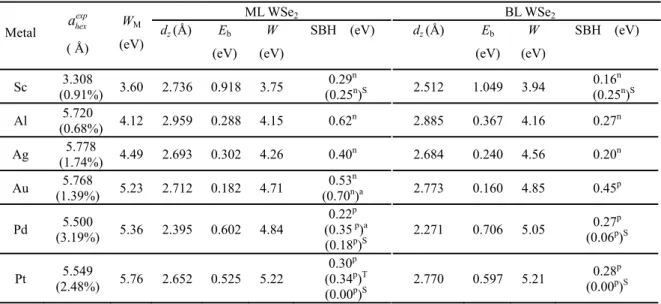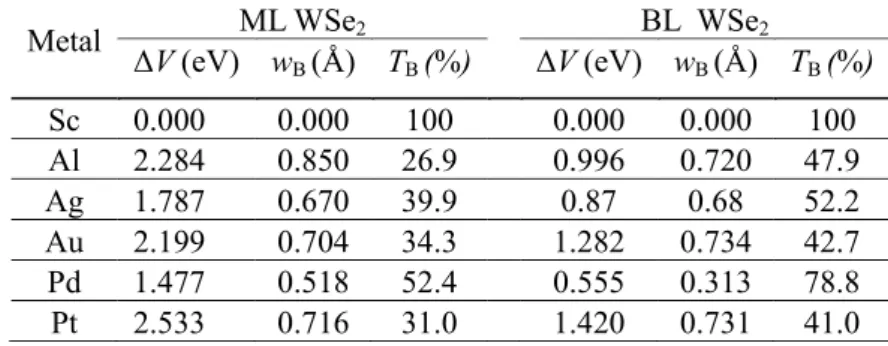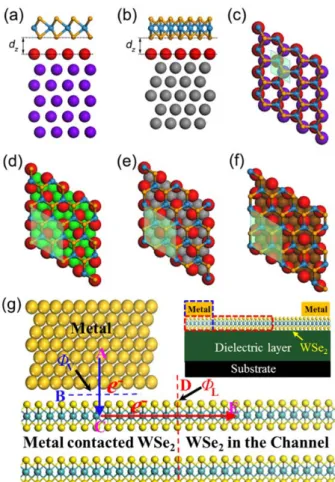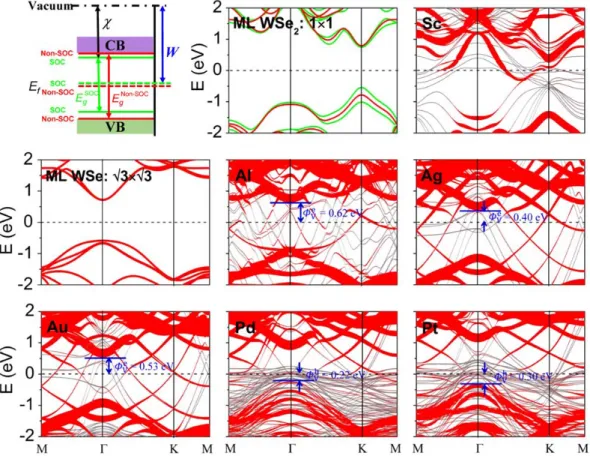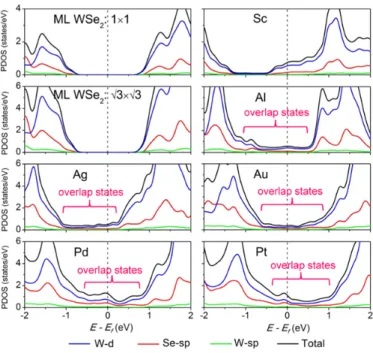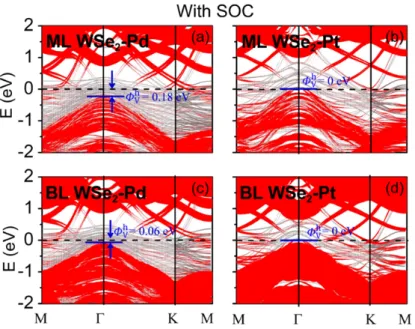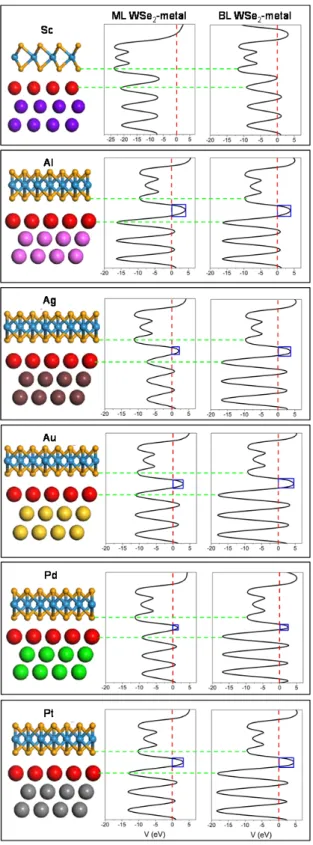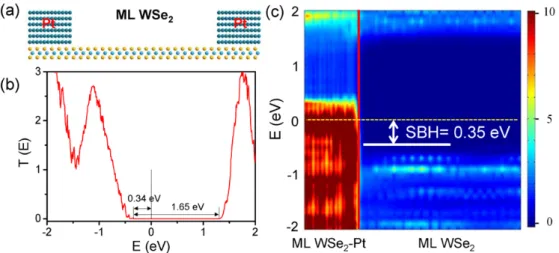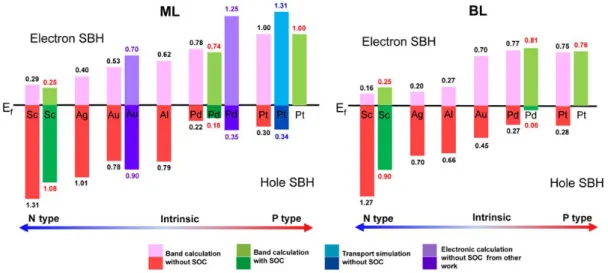Does p-type ohmic contact exist in
WSe[subscript 2]–metal interfaces?
The MIT Faculty has made this article openly available.
Please share
how this access benefits you. Your story matters.
Citation
Wang, Yangyang et al. “Does P-Type Ohmic Contact Exist in WSe 2#?
metal Interfaces?” Nanoscale 8.2 (2016): 1179–1191.
As Published
http://dx.doi.org/10.1039/c5nr06204g
Publisher
Royal Society of Chemistry
Version
Original manuscript
Citable link
http://hdl.handle.net/1721.1/110073
Terms of Use
Creative Commons Attribution-Noncommercial-Share Alike
1
Does P-type Ohmic Contact Exist in WSe
2-metal Interfaces?
Yangyang Wang,1, 3,† Ruoxi Yang,1,4,† Ruge Quhe,1,5,6,† Hongxia Zhong,1,7,† Linxiao Cong,1 Meng
Ye,1 Zeyuan Ni,1 Zhigang Song,1 Jinbo Yang,1,2 Junjie Shi,1 Ju Li,3 and Jing Lu1,2,*
1 State Key Laboratory for Mesoscopic Physics and Department of Physics, Peking University,
Beijing 100871, P. R. China
2 Collaborative Innovation Center of Quantum Matter, Beijing 100871, P. R. China 3 Department of Nuclear Science and Engineering and Department of Materials Science and
Engineering, Massachusetts Institute of Technology, Cambridge, Massachusetts 02139 , USA
4 Department of Chemistry, University of Bath, Claverton Down, Bath BA2 7AY, UK 5 State Key Laboratory of Information Photonics and Optical Communications, Beijing
University of Posts and Telecommunications & School of Science, Beijing 100876, China
6 Academy for Advanced Interdisciplinary Studies, Peking University, Beijing 100871, China 7 Department of Physics, Washington University in St. Louis, St. Louis, Missouri 63130, USA
†These authors contributed equally to this work. *Address correspondence to: jinglu@pku.edu.cn
Abstract
Formation of low-resistance metal contacts is the biggest challenge that masks the intrinsic exceptional electronic properties of 2D WSe2 devices. We present the first comparative study of the
interfacial properties between ML/BL WSe2 and Sc, Al, Ag, Au, Pd, and Pt contacts by using ab
initio energy band calculations with inclusion of the spin-orbital coupling (SOC) effects and
quantum transport simulations. The interlayer coupling tends to reduce both the electron and hole Schottky barrier heights (SBHs) and alters the polarity for WSe2-Au contact, while the SOC chiefly
reduces the hole SBH. In the absence of the SOC, Pd contact has the smallest hole SBH with a value no less than 0.22 eV. Dramatically, Pt contact surpasses Pd contact and becomes p-type Ohmic or quasi-Ohmic contact with inclusion of the SOC. Our study provides a theoretical foundation for the selection of favorable metal electrodes in ML/BL WSe2 devices.
Keywords: WSe2, Interface, Schottky barrier, Density functional theory, Quantum transport
2
Introduction
Two dimensional (2D) transition-metal dichalcogenides (TMDs) are attracting much recent attention because they have a wide range of application prospects in electronics,1-6 photoelectronics,1, 7-9 spintronics,10-12 and valleytronics.11, 13-18 Among 2D TMDs, monolayer (ML) and bilayer (BL)
MoS2 and WSe2 are probably most intensively studied. 2D WSe2 distinguishes it from 2D MoS2
mainly in two aspects: (1) 2D WSe2 has a much enhanced spin-orbit coupling (SOC) due to heavier
W and Se atoms.11, 12 For example, the splitting of the valence band maximum (VBM) is about 0.15 eV in ML MoS2 but is enhanced to 0.46 eV in ML WSe2.11 Therefore, 2D WSe2 is more suitable for
spintronics purpose. (2) 2D MoS2 favors n-type doping,2, 3, 19 whereas 2D WSe2 prefers p-type
doping as a result of much higher positions of the conduction band minimum (CBM) and the VBM.5,
6A p-n junction can be fabricated with 2D MoS
2 as n region and 2D WSe2 as p region, and such a
device has been reported recently, with excellent rectification behavior and rapid photoresponse.16, 20
A device often needs a contact with metal electrodes, and the formation of low-resistance metal contacts is the biggest challenge that masks the intrinsic exceptional electronic properties of 2D TMDs.19 In the absence of a controllable and sustainable substitutional doping scheme, one has to
rely on the work function of contact metals to inject appropriate types of carriers into the respective bands of 2D TMDs. Such metal-semiconductor contacts are often associated with a formation of finite Schottky barrier, which decreases the carrier injection efficiency. Apparently, decreasing Schottky barrier height (SBH) is critical to reach a high performance of a device, and a low resistance Ohmic contact with vanishing SBH is highly desirable. Unfortunately, the SBH does not simply depend on the difference between the intrinsic Fermi level (Ef) of a metal and the CBM or
VBM of the semiconductor due to the complex Fermi level pinning, which renders the appearance of Ohmic contact rather difficult.21, 22 There have been a lot of works to study 2D MoS2-metal
interfaces.19, 23-27
However, no n-type low-resistance Ohmic contact has been revealed either
experimentally or theoretically in 2D MoS2 even with low work function metals such as Ti and Sc in
terms of the recent reports 3, 19, 21, 28
Compared with those about MoS2, the studies of 2D WSe2-metal interfaces are much limited. In
the experimental aspect, Javey et al.’s measurement showed that high work function Pd forms the lowest resistance to the valence band of ML WSe2 for hole transport, while lower function Ag, Ni,
Au, Ti, and Gd have high SBH to both the valence band and the conduction band of ML WSe2.5
Banerjee et al.’s measurement showed that Al forms a n-type Schottky contact with ML WSe2, but
3
present in ML WSe2 and In, Ti, Al, Au, and Pd interfaces, where the SOC is not considered in the
energy band calculations.4, 19 Three fundamental issues arise: (1) Which elemental metal has the
smallest hole SBH when contacted with WSe2? (2) Whether p-type Ohmic contact is present in ML
WSe2-metal contacts? (3) What are the effects of the SOC on the SBH of ML WSe2-metal contacts?
The SBH depends on the difference between Ef of the metal electrode and the band edge of the
channel semiconductor in a device environment. Given a rise of 0.23 eV of the VBM due to the SOC splitting in ML WSe2,11 the ignorance of it in determining the hole SBH appears rather
unacceptable unless existence of a full Fermi level pining during the SOC process.
Due to the strong interlayer coupling, BL WSe2 has a reduced band gap compared with ML one
(1.44 eV vs 1.67 eV at the density functional theory (DFT) level).29 Therefore, a reduced SBH and
thus a higher carrier injection efficiency can be expected in BL WSe2-metal contacts, suggesting a
better device performance of BL WSe2 as the channel compared with ML WSe2 given an identical
gate voltage controllability.However, to the best of our knowledge, the interfacial properties of BL WSe2-metal contacts have not been investigated.
In this Article, we provide a comparative study of the interfacial properties of ML and BL WSe2
on several commonly used metals (Sc, Al, Ag, Au, Pd, and Pt), for the first time by using the DFT energy band calculation with inclusion of the SOC effects. We find that the interlayer coupling decreases both the electron and hole SBHs and even alters the polarity of WSe2-Au contact. No
Ohmic contact is revealed in the absence of the SOC, and Pd contact has the minimum hole SBH (0.22/0.27 eV for ML/BL WSe2 case). However, when the SOC is included, ML and BL WSe2-Pt
interfaces dramatically have the minimum hole SBHs and actually become p-type Ohmic or quasi-Ohmic contact. A more reliable approach to treat the SBH is ab initio quantum transport simulation based on a two-probe model, which is also performed and gives a hole SBH similar to that of the energy band calculation for ML WSe2-Pt interface in the absence of the SOC.
Results and Discussion
Interface modeling and stability
We use six layers of metal atoms (Sc in (0001) orientation and Al, Ag, Au, Pd and Pt in (111) orientation) to model the metal surface and adjust them to match the optimized lattice constant of ML and BL WSe2. The calculated in-plane lattice constant of WSe2 is a = 3.29 Å, in good agreement
with the experimental value.30 The (1 1) unit cell of Sc (0001) face is adjusted to the (1 1) unit
cell of WSe2, and (2 × 2) unit cells of Al, Ag, Au, Pd and Pt (111) faces are adjusted to the (√3 × √3)
4
fixed during the relaxation. A vacuum buffer space of at least 20 Ǻ is set to avoid spurious interaction between periodic images. The most stable ML WSe2-metal contact geometries are
obtained by optimizing the structures from different initial configurations. The initial configurations of BL WSe2-metal interfaces are constructed in terms of AA stacking in WSe2 (a D3d point group
symmetry)31 on the basis of the most stable ML WSe
2-metal interface configurations.
The most stable configurations of the ML WSe2-metal interfaces are shown in Figure 1. The
relative positions between ML WSe2 and metal substrates along the interface directions are different
for different metals. On Sc(0001) surface, the W atoms in the primitive cell sit above the top metal atoms, and the Se atoms sit above the second layer metal atoms (Figure 1c); On Al and Pt (111) surfaces, the W atoms in the supercell are all above the centers of the triangles formed by the fcc, hcp, and top sites, and the three pairs of Se atoms sit above the fcc, hcp, and top sites, respectively (Figure 1d); On Pd (111), the three W atoms in the supercell sit above the fcc, hcp, and top sites, respectively, and the Se atoms are all above the centers of the triangles formed by the fcc, hcp, and top sites (Figure 1e); On Ag and Au(111), the W and Se atoms are all above the centers of the triangles formed by the fcc, hcp, and top sites (Figure 1f). The most stable configurations of the BL WSe2-metal interfaces are similar with the corresponding ML ones. The equilibrium interfacial
distances dz in ML and BL WSe2-metal contacts are insensitive to the WSe2 layer number, varying
from 2.271-2.959 Å (Table 1). The binding energy per interfacial W atom is defined as
Eb = (EWSe2 + Emetal − EWSe2-metal)/NW (1)
Where EWSe2, Emetal, and EWSe2-metal are the relaxed energies for WSe2, metal surface, and the
combined system per supercell, respectively, and NW is the number of interface W atoms per
supercell. Eb ranges from 0.160 to 1.049 eV as listed in Table 1. Similar to the cases of MoS2,19 the
adsorption of ML and BL WSe2-metal surfaces can be classified into weak bonding (Al, Ag and Au
contacts) with Eb = 0.160-0.367 eV, medium bonding (Pt and Pd) with Eb = 0.525-0.706 eV, and
strong bonding (Sc) with Eb = 0.918 (ML) and 1.049 (BL) eV according to the binding strength.
It is important to note that there are two possible interfaces to form Schottky barrier in a transistor as shown in Figure 1g: one is the source/drain interface (B) between the contacted WSe2
and the metal surface in the vertical direction if the interaction between WSe2 and the metal surface
is weak, and the other is source/drain-channel (D) interface between the contacted WSe2 and channel
WSe2 in the lateral direction if the interaction between WSe2 and the metal surface is strong. Such a
dual interface model has been employed in the recent MoS2-, graphdiyne-, and ML
5
predicts an Ohmic contact between ML MoS2 and Ti due to the strong band hybridization,26 the dual
interface model predicts a Schottky contact with an electron SBH of 0.22-0.35 eV.19, 21 A significant
electron SBH of 0.30-0.35 eV between ML MoS2 and Ti is found experimentally,19 justifying the
dual interface model. Actually, the calculated (0.096 eV) and observed (0.065 eV) electron SBH for BL MoS2-Ti21, 33 based on the dual interface model also show a good consistency.
Vertical SBH and overlap states
The band structures of ML WSe2 and the combined systems are shown in Figure 2. The ML
WSe2 has a band gap of 1.60 eV when the SOC is considered, consistent with the reported DFT
value of 1.67 eV.29 Both the valence and conduction bands of ML WSe
2 are strongly destroyed when
contacted with Sc, resulting in an absent vertical Schottky barrier for ML WSe2-Sc contact. The
majority of the ML WSe2 bands are still identifiable when contacted with Al, Ag and Au surfaces
because the weak interaction. When contacted with Pt and Pd surfaces, the valence bands of ML WSe2 are hybridized slightly with the d-bands of Pt and Pd, while the conduction bands are
preserved well. Vertical Schottky barrier ΦVe/h for these weak or medium bonding cases (Figure 1g) can be obtained from the energy difference between Ef of the interfacial system and the CBM
(electron SBH) or VBM (hole SBH) of the contacted WSe2. In ML WSe2-Al, -Ag and -Au contacts,
as shown in Figure 2, the vertical Schottky barriers are n-type with electron SBH of ΦVe = 0.62, 0.40, and 0.53 eV, respectively. While in ML WSe2-Pd and -Pt contacts, the vertical Schottky
barriers are p-type with hole SBH of ΦVh = 0.22 and 0.30 eV, respectively. The vertical electron/hole SBH in ML WSe2-Au/-Pd contact (0.53/0.22 eV) is comparable with the one
(0.70/0.35 eV) calculated by Banerjee et al.19 in the absence of the SOC effects. The nearly midgap
SBH character of Al contact (ΦVe= 0.62 eV and ΦVh= 0.79 eV ) is also consistent with the PDOS calculations of Banerjee et al..4
The band hybridization degree of the ML WSe2-metal surfaces increases with the binding
strength. The different bonding strength and band hybridization degree in different interfaces can be well explained by the d-band model.34 Al has no d-orbitals and Ag and Au have full d-shells and
they all bond with ML WSe2 weakly, whereas Pt and Sc have open d-shells and bond with ML WSe2
strongly. The relative position of d-band also plays an important role. As moving from the right to
the left in the periodic table, the d-band moves up in energy. Although Pd and Ag both have full 4d-shells, the d-band of Pd is located nearer to Ef than that of Ag thus strongly hybridizes with the
6
energy. Therefore, the conduction bands of ML WSe2 are perturbed more seriously than its valence
bands when contacted with Sc.
To further study the contact natures in the vertical direction, the partial density of states (PDOS) of W and Se atoms in ML WSe2-metal contacts are provided in Figure 3. After contacted with metal
faces, there appear electronic states in the original band gap of ML WSe2. PDOS at Ef (N(Ef))
increases in this order: Au (0.39) < Al (0.50) < Ag (0.58) < Pt (1.08) < Pd (1.24) < Sc (2.1), a result consistent with the hybridization degree (for Sc contact, we compare its 3N(Ef) value with the N(Ef)
of other metal contacts because its interface unit cell area is 1/3 of others). The prominent overlap
between Sc and WSe2 in the original band gap of WSe2 indicates a covalent bond formation between
them, thus further confirming the absence of vertical Schottky barrier. In contrast, there are much fewer overlap states distributed in the original band gap for other contacts compared with those in the Sc contact. Because the overlap states near Ef contribute to the electron or hole injections from
the metal, the PDOS value at Ef to a degree can reflect the quality of vertical contacts.
The electronic structures of free-standing BL WSe2 and BL WSe2-metal interfaces are shown in
Figure 4, with a smaller indirect band gap of 1.43 eV for free-standing BL WSe2. The band
hybridization degree is similar to ML and can also be divided into the same three categories. The
vertical Schottky barrier in BL WSe2-Sc system is also absent due to the strong hybridization
between the bands of BL WSe2 and Sc. In BL WSe2-Al, -Ag, -Pd and -Pt contacts, the type of the
vertical Schottky barrier is same as the ML case; the Schottky barriers are n-type with e V
Φ = 0.27 and 0.20 eV in BL WSe2-Al and -Ag, and are p-type with ΦVh= 0.27 and 0.28 eV in BL WSe2-Pd
and -Pt, respectively. In these four metal contacts, e V
Φ is decreased significantly in the n-type contacts while h
V
Φ is not altered much in the p-type contacts compared with those in the cases of ML. The vertical Schottky barrier changes from weak n-type in ML WSe2-Au contact to weak
p-type with h V
Φ = 0.45 eV in BL case. In both cases, Ef is close to the band gap center of WSe2.
Experimentally, ambipolarity is observed in few layer WSe2 FET with Au electrode, a result
consistent with our calculation.35
WSe2 hosts heavy 5d elements with strong atomic SOC, much stronger than that in the more
intensively studied MoS2 system.11 After inclusion of the SOC effects, the band structures of ML and
BL WSe2 are greatly modified as shown in the first and second panels of Figure 2 and 4 by lining up
the bands with the vacuum level. The band gap of ML (BL) WSe2 is reduced from 1.60(1.43) to
1.33(1.15) eV. The CBM of ML (BL) WSe2 is changed slightly and only falls by 0.04 (-0.09) eV, but
7
the Fermi level pinning is absent, the electron vertical SBH is little affected, but the hole vertical SBH is decreased remarkably by about 0.23 (0.37) eV for ML (BL) case once the SOC effects are included. As shown in Figure 5, the CBMs of ML and BL WSe2 is little changed (within 0.04 eV) in
the Pd and Pt contacts when the SOC is included. By contrast, the VBM of ML (BL) WSe2 is lifted
by 0.04 (0.21) eV in ML (BL) WSe2-Pd contact after inclusion of the SOC effect, and thus we have
a reduced h V
Φ = 0.18 (0.06) eV for hole injection. The VBM in ML (BL) WSe2-Pd contact is not
elevated as high as in free-standing ML (BL) WSe2, reflecting a partial Fermi level pining during the
SOC process. The reduction in h V
Φ is especially remarkable in Pt contact. The VBM of WSe2
touches Ef in ML and BL WSe2-Pt contacts after inclusion of the SOC effects because of the
significant rise of the VBM by about 0.30 and 0.28 eV, respectively, leading to Ohmic or quasi-Ohmic interfaces. The rise amplitudes of the VBM in ML and BL WSe2-Pt contacts are
comparable with those in free-standing ML and BL WSe2, implying a much depressed or even
vanishing Fermi level pining during the SOC process in Pt contact. The dramatic change in the hole SBH indicates the importance of the SOC in determining the interfacal properties of 2D WSe2-metal
contacts and it is not ignorable. The predicted p-type quasi-Ohmic contact for ML and BL WSe2-Pt
appears in agreement with the recent experimental results of Javey et al. that the p-type WSe2 FET in
contact with metal Pt/Au/Pd electrode has almost linear output characteristics in the low-voltage regime.6
Lateral SBH
Because of the covalent bonding between WSe2 and Sc, ML (BL) WSe2-Sc can be regarded as a
new metallic material. A lateral Schottky barrier is formed at the interface D, and its height e/h L
Φ is
determined by the energy difference between Ef of the WSe2-Sc complex system and the CBM
(electron SBH) or VBM (hole SBH) of channel WSe2. Because ΦLe/hdepends on the absolute band
edge positions of the semiconductor channel, the band edge positions of the semiconductor channel must be accurately determined. As has been testified in MoS2-metal contacts, many-electron effect is
greatly depressed by the charge transfer between channel TMD and the electrode and the doping caused by gate,21 which significantly screen the electron-electron Coulomb interaction. As a rule of
thumb, the transport gap of 2D TMD channel could be determined by the DFT band gap rather than the quasi-particle band gap. As shown in Figure S1, lateral n-type Schottky barriers are formed for ML and BL WSe2-Sc contacts with electron SBHs ΦLe(Non-SOC)= 0.29 and 0.16 eV and
e(SOC) L
Φ =
0.25 and 0.25 eV, respectively.
8
The partial Fermi level pinning is a synergic result of the metal work function modification and the interface states formation in the studied interface systems.23 Fermi level pinning makes the
contact nature complex and difficult to predict. We define the Fermi energy shift ΔEf as
(2)
where ED is the middle energy of the band gap of the WSe2 adsorbed on metal substrates, Ef is the
Fermi level of the interfacial system, W and WWSe2 are the work functions of the interfacial system
and pristine ML or BL WSe2, respectively. Negative (positive) ΔEf means n-type (p-type) doping of
WSe2. ΔEf as a function of the difference between the clean metal and ML (BL) WSe2 work
functions WM WWSe2 is shown in Figure S2. We applying a linear fit to all the data obtained with or
without the SOC effects. The slope is 0.40 in both ML and BL WSe2-metal contacts. The slope close
to 1 means no Fermi level pinning and close to 0 indicates a strong Fermi level pinning. We therefore observe a partial Fermi level pinning picture in the six ML (BL) WSe2-metals contacts.
Tunneling barrier
The tunneling barrier is another figure of merit to evaluate a contact, here its height ΔV defined as the potential energy above Ef between the WSe2 and metal surfaces, indicated by the black
rectangular in Figure 6, and its width wB defined as the full width at half maximum of the ΔV. As
shown in Figure 6 and Table 2, the tunneling barrier is insensitive to the number of WSe2 layers. The
weak bonding (Al, Ag and Au) and medium bonding (Pd and Pt) interfaces have a notably high ΔV and a notably wide wB. On the contrary, there is no tunneling barrier at the strong bonding interfaces
(Sc, and Ti), indicating a higher electron injection efficiency and thus a lower contact resistance. We estimate the tunneling probabilities TB from metal to WSe2 using a square potential barrier model as:
(3) where m is the effective mass of a free electron and ħ is the Plank’s constant. The TB values are thus
estimated to be 100 (100), 26.9 (47.9), 39.9 (52.2), 34.3 (42.7), 52.4 (78.8) and 31.0 (41.0)% for ML (BL) WSe2-Sc, Al, Ag, Au, Pd and Pt contacts, respectively. Apparently, Sc contacts have a perfect
tunneling transmission.
Quantum transport simulation
A more direct and reliable approach to determine the SBH of a 2D WSe2 transistor is the ab initio
quantum transport simulation. As an example, in Figure 7(a), we present the simulated transport properties of ML WSe2 transistor with Pt electrodes (the SOC is not included). The length of the
) 2 2 exp( B B h V m T barrier Schottky lateral for , barrier Schottky al for vertic , 2 WSe f D W W E E Ef
9
channel is 73 Å. From the transmission spectrum shown in Figure 7(b), we can see a transport gap of 1.65 eV and a hole SBH of 0.34 eV. From the local density of states plotted in Figure 7(c), a band gap of ~1.8 eV in the free ML WSe2 region (dark blue) and a hole SBH of ~ 0.35 eV are clearly
visible, comparable with the corresponding values derived from the transmission spectrum. The band bending of the free ML WSe2 near the interface is not sharp, showing a weak built-in electric
field between the source/drain and channel region. The SBH calculated in the transport simulation (0.34-0.35 eV) is also close to that (0.29 eV) calculated from the energy band analysis without inclusion of the SOC.
This good agreement indicates that the energy band calculation is suitable in describing the vertical SBH in the weak bonding contacts although it often gives an artificial vanishing lateral SBH in the strong bonding contacts.21, 32 The reason lies in that in the vertical SBH calculation of a weak
bonding contact, the coupling between the metal surface and the semiconductor is taken into account where the two parts are treated as a whole, but in the lateral SBH calculation of a strong bonding contact, the coupling between the source/drain region (metal and metal contacted 2D semiconductor) and the channel semiconductor is not considered where they are treated separately. We therefore believe that the Ohmic or quasi-Ohmic feature of ML/BL WSe2-Pt contacts should be kept in a
quantum transport simulation with inclusion of the SOC though it is unavailable now.
To provide a clear picture, the SBHs obtained by different methods are summarized in Figure 8. When contacted with the same metal, compared with those in ML case, the electron and hole SBHs in BL case both tend to be decreased due to the much reduced band gap. From left to right, the ML and BL WSe2 are gradually changed from n- to p-type doping, which can be utilized to build pn
junctions, the most fundamental device building blocks for diverse optoelectronic functions. A ML WSe2 device with Ti as cathode and Pd as anode is synthesized and can serve as a solar cell,
photodiode, and light-emitting diode with impressive performances.9 P-type ML WSe
2-Pd contact
has a smaller SBH compared with Ag and Au contacts, which is well consistent with the contact resistance measurement.5 In the absence of the SOC, Pd contact has the smallest hole SBH with a
value no less than 0.22 eV though Pt has a larger work function than Pd (5.76 eV vs 5.36 eV in our work as given in Table 1). However, Pt contact wins the smallest hole SBH (actually 0 eV) in the presence of the SOC.
In the light of Schottky barrier and tunneling barrier, the nature of investigated ML WSe2-metal
contacts can be classified into four types as summarized in Figure 9. ML WSe2-Sc contact is type I
10
tunneling barrier exists in the rest three types of contacts. Schottky barrier is formed at the interface B in type II (n-type) and III (p-type). The nature of ML WSe2-Al, -Ag and -Au belongs to type II
(Figure 9b) and that of ML WSe2-Pd belongs to type III (Figure 9c). Type IV (ML WSe2-Pt) can be
expected as an excellent contact interface with an Ohmic or quasi-Ohmic contact (Figure 9d). However, the tunneling barrier with moderate tunneling probabilities (31.0% for Pt) would degrade its performance. As for BL WSe2, BL WSe2-Sc, Al, Ag, Pd and Pt interfaces keep the same contact
type as the corresponding ML ones. However, WSe2-Au changes into type IV contact in BL case.
Conclusion
We provide the first comparative study of the interfacial properties of ML and BL WSe2 on Sc,
Al, Ag, Au, Pd, and Pt surfaces by using ab initio energy band calculations with inclusion of the SOC effects and a dual interface model. Compared with ML WSe2-metal contacts, the electron and
hole SBHs are decreased in BL WSe2-metal contacts due to the smaller band gap in BL WSe2, and
the polarity of WSe2-Au contact changes from n-type to p-type. The hole SBH is greatly reduced by
the SOC effects in both ML and BL WSe2-metal contacts. In the absence of the SOC, Pd contact has
the smallest hole SBH with a value no less than 0.22 eV. Dramatically, p-type Ohmic or quasi-Ohmic contact appears in ML and BL WSe2-Pt interfaces with inclusion of the SOC. Ab initio
quantum transport simulation gives a similar SBH for ML WSe2-Pt interface in the absence of the
SOC. This fundamental study gives a deep insight into 2D WSe2-metal interfaces and provides a
theoretical foundation for the selection of metal electrodes in WSe2 devices.
Methods
The geometry optimizations are carried out by employing the CASTEP package36 with the
ultrasoft pseudopotential37 and plane-wave basis set. The cut-off energy is 400 eV. To take the
dispersion interaction into account, a DFT-D semiempirical dispersion-correction approach is used with the Ortmann-Bechstedt-Schmidt (OBS) scheme.38 The dipole correction to the total energies is
adopted. The stopping criteria for the ionic relaxation are such that the remnant force on each atom is below 0.01 eV/Å and that energies are converged to within 10-5 eV per atom. The electronic
structures are calculated with the projector-augmented wave (PAW) pseudopotential39, 40 and
plane-wave basis set with a cut-off energy of 400 eV implemented in the Vienna ab initio simulation package (VASP) in order to analyze the band components.41-44 The Monkhorst-Pack45 k-point mesh
is sampled with a separation of about 0.10 and 0.03 Å-1 in the Brillouin zone during the relaxation
and electronic calculation periods, respectively. Our tests show that the band structures generated from CASTEP and VASP packages coincide well.
11
The WSe2 transistor is simulated using the DFT coupled with the nonequilibrium Green's
function (NEGF) method, as implemented in the ATK 11.8 package [46, 47]. The single-zeta plus polarization (SZP) basis set is used. The Monkhorst-Pack k-point meshes for the central region and electrodes are sampled with 1×50×1 and 50×50×1 separately. The temperature is set to 300 K. The Neumann condition is used on the boundaries of the direction vertical to the WSe2 plane. On the
surfaces connecting the electrodes and the central region, we employ Dirichlet boundary condition to ensure the charge neutrality in the source and the drain region. The transmission coefficient at energy E averaged over 50 ky-points perpendicular to the transport direction (x direction) is obtain
by
(4)
Where Gr(a) is the retarded (advanced) Green function and
(
)
(
)
) ( ) ( ) (R rLR aL R LE
i
is the level broadening due to left (right) electrode expressed in terms of the electrode self-energy ΣL(R).Throughout the paper, the generalized gradient approximation (GGA) functional to the exchange-correction functional of the Perdew–Wang 91 (PW91) form46 is adopted.
Acknowledgements
This work was supported by the National Natural Science Foundation of China (Nos. 11274016,
11474012, 11047018, and 60890193), the National Basic Research Program of China (Nos. 2013CB932604 and 2012CB619304), Fundamental Research Funds for the Central Universities, and National Foundation for Fostering Talents of Basic Science (No. J1030310/No. J1103205).
Additional information
Competing financial interests: The authors declare no competing financial interest.
Corresponding Author
Correspondence to: Jing Lu (jinglu@pku.edu.cn)
)] ( ) ( [ Tr ) (E G E G E T a R L r
12
References
1. Wang, Q. H.; Kalantar-Zadeh, K.; Kis, A.; Coleman, J. N.; Strano, M. S. Electronics and Optoelectronics of Two-dimensional Transition Metal Dichalcogenides. Nature Nanotech. 2012, 7 (11), 699-712.
2. Radisavljevic, B.; Radenovic, A.; Brivio, J.; Giacometti, V.; Kis, A. Single-layer MoS2
Transistors Nature Nanotech. 2011, 6 (3), 147-150.
3. Das, S.; Chen, H.-Y.; Penumatcha, A. V.; Appenzeller, J. High Performance Multilayer MoS2
Transistors with Scandium Contacts. Nano Lett. 2013, 13 (1), 100-105.
4. Liu, W.; Kang, J.; Sarkar, D.; Khatami, Y.; Jena, D.; Banerjee, K. Role of Metal Contacts in Designing High-Performance Monolayer n-Type WSe2 Field Effect Transistors. Nano Lett. 2013, 13
(5), 1983-1990.
5. Fang, H.; Chuang, S.; Chang, T. C.; Takei, K.; Takahashi, T.; Javey, A. High-Performance Single Layered WSe2 p-FETs with Chemically Doped Contacts. Nano Lett. 2012, 12 (7), 3788-3792.
6. Tosun, M.; Chuang, S.; Fang, H.; Sachid, A. B.; Hettick, M.; Lin, Y.; Zeng, Y.; Javey, A. High-Gain Inverters Based on WSe2 Complementary Field-Effect Transistors. ACS Nano 2014, 8 (5),
4948-4953.
7. Zhao, W.; Ribeiro, R. M.; Eda, G. Electronic Structure and Optical Signatures of Semiconducting Transition Metal Dichalcogenide Nanosheets. Acc. Chem. Res. 2014, 48 (1), 91-99. 8. Ross, J. S.; Klement, P.; Jones, A. M.; Ghimire, N. J.; Yan, J.; Mandrus, D. G.; Taniguchi, T.; Watanabe, K.; Kitamura, K.; Yao, W.; Cobden, D. H.; Xu, X. Electrically Tunable Excitonic Light-emitting Diodes Based on Monolayer WSe2 p-n Junctions. Nature Nanotech. 2014, 9 (4),
268-272.
9. Pospischil, A.; Furchi, M. M.; Mueller, T. Solar-energy Conversion and Light Emission in an Atomic Monolayer p-n Diode. Nature Nanotech. 2014, 9 (4), 257-261.
10. Neal, A. T.; Liu, H.; Gu, J.; Ye, P. D. Magneto-transport in MoS2: Phase Coherence, Spin–Orbit
Scattering, and the Hall Factor. ACS Nano 2013, 7 (8), 7077-7082.
11. Xiao, D.; Liu, G.-B.; Feng, W.; Xu, X.; Yao, W. Coupled Spin and Valley Physics in Monolayers of MoS2 and Other Group-VI Dichalcogenides. Phys. Rev. Lett. 2012, 108 (19), 196802.
12. Yuan, H.; Bahramy, M. S.; Morimoto, K.; Wu, S.; Nomura, K.; Yang, B.-J.; Shimotani, H.; Suzuki, R.; Toh, M.; Kloc, C.; Xu, X.; Arita, R.; Nagaosa, N.; Iwasa, Y. Zeeman-type Spin Splitting Controlled by an Electric Field. Nature Phys. 2013, 9 (9), 563-569.
13. Xu, X.; Yao, W.; Xiao, D.; Heinz, T. F. Spin and Pseudospins in Layered Transition Metal Dichalcogenides. Nature Phys. 2014, 10 (5), 343-350.
14. Jones, A. M.; Yu, H.; Ghimire, N. J.; Wu, S.; Aivazian, G.; Ross, J. S.; Zhao, B.; Yan, J.; Mandrus, D. G.; Xiao, D.; Yao, W.; Xu, X. Optical Generation of Excitonic Valley Coherence in Monolayer WSe2. Nature Nanotech. 2013, 8 (9), 634-638.
15. Mak, K. F.; McGill, K. L.; Park, J.; McEuen, P. L. The Valley Hall Effect in MoS2 Transistors.
Science 2014, 344 (6191), 1489-1492.
16. Lee, C.-H.; Lee, G.-H.; van der Zande, A. M.; Chen, W.; Li, Y.; Han, M.; Cui, X.; Arefe, G.; Nuckolls, C.; Heinz, T. F.; Guo, J.; Hone, J.; Kim, P. Atomically Thin p–n Junctions with Van der Waals Heterointerfaces. Nature Nanotech. 2014, 9 (9), 676-681.
17. Sie, E. J.; McIver, J. W.; Lee, Y.-H.; Fu, L.; Kong, J.; Gedik, N. Valley-selective Optical Stark Effect in Monolayer WS2. Nature Mater. 2015, 14, 290–294.
18. Kim, J.; Hong, X.; Jin, C.; Shi, S.-F.; Chang, C.-Y. S.; Chiu, M.-H.; Li, L.-J.; Wang, F. Ultrafast Generation of Pseudo-magnetic Field for Valley Excitons in WSe2 Monolayers. Science 2014, 346
(6214), 1205-1208.
19. Kang, J.; Liu, W.; Sarkar, D.; Jena, D.; Banerjee, K. Computational Study of Metal Contacts to Monolayer Transition-Metal Dichalcogenide Semiconductors. Phys. Rev. X 2014, 4 (3), 031005. 20. Cheng, R.; Li, D.; Zhou, H.; Wang, C.; Yin, A.; Jiang, S.; Liu, Y.; Chen, Y.; Huang, Y.; Duan, X. Electroluminescence and Photocurrent Generation from Atomically Sharp WSe2/MoS2
Heterojunction p–n Diodes. Nano Lett. 2014, 14 (10), 5590-5597.
21. Zhong, H.; Ni, Z.; Wang, Y.; Ye, M.; Song, Z.; Pan, Y.; Quhe, R.; Yang, J.; Yang, L.; Shi, J.; Lu, J. Interfacial Properties of Monolayer and Bilayer MoS2 Contacts with Metals: Depressed
Many-electron Effects. arXiv:1501.01071 [cond-mat.mes-hall] 2015.
13
Yang, J.; Lu, J. Graphdiyne-metal Contacts and Graphdiyne Transistors. Nanoscale 2015, 7 (5), 2116-2127.
23. Gong, C.; Colombo, L.; Wallace, R. M.; Cho, K. The Unusual Mechanism of Partial Fermi Level Pinning at Metal–MoS2 Interfaces. Nano Lett. 2014, 14 (4), 1714-1720.
24. Kang, J.; Liu, W.; Banerjee, K. High-performance MoS2 Transistors with Low-resistance
Molybdenum Contacts. Appl. Phys. Lett. 2014, 104 (9), 093106.
25. Chen, W.; Santos, E. J. G.; Zhu, W.; Kaxiras, E.; Zhang, Z. Tuning the Electronic and Chemical Properties of Monolayer MoS2 Adsorbed on Transition Metal Substrates. Nano Lett. 2013, 13 (2),
509-514.
26. Popov, I.; Seifert, G.; Tománek, D. Designing Electrical Contacts to MoS2 Monolayers: A
Computational Study. Phys. Rev. Lett. 2012, 108 (15), 156802.
27. Wei, L.; Jiahao, K.; Wei, C.; Sarkar, D.; Khatami, Y.; Jena, D.; Banerjee, K. High-performance Few-layer-MoS2 Field-effect-transistor with Record Low Contact-resistance, IEEE International
Electron Devices Meeting (IEDM), Washington DC, Dec. 9-11, 2013, 499–502
28. Amani, M.; Chin, M. L.; Birdwell, A. G.; O’Regan, T. P.; Najmaei, S.; Liu, Z.; Ajayan, P. M.; Lou, J.; Dubey, M. Electrical Performance of Monolayer MoS2 Field-effect Transistors Prepared by
Chemical Vapor Deposition. Appl. Phys. Lett. 2013, 102 (19), 193107.
29. Yun, W. S.; Han, S. W.; Hong, S. C.; Kim, I. G.; Lee, J. D. Thickness and Strain Effects on Electronic Structures of Transition Metal Dichalcogenides: 2H-MX2 Semiconductors (M= Mo, W;
X= S, Se, Te). Phys. Rev. B 2012, 85 (3), 033305.
30. Al-Hilli, A. A.; Evans, B. L. The Preparation and Properties of Transition Metal Dichalcogenide Single Crystals. J. Cryst. Growth 1972, 15 (2), 93-101.
31. Liu, Q.; Li, L.; Li, Y.; Gao, Z.; Chen, Z.; Lu, J. Tuning Electronic Structure of Bilayer MoS2 by
Vertical Electric Field: A First-Principles Investigation. J. Phys. Chem. C 2012, 116 (40), 21556-21562.
32. Pan, Y.; Wang, Y.; Ye, M.; Quhe, R.; Zhong, H.; Song, Z.; Peng, X.; Li, J.; Yang, J.; Shi, J.; Lu, J. Monolayer Phosphorene-Metal Interfaces. 2015, in preparation.
33. Qiu, H.; Pan, L.; Yao, Z.; Li, J.; Shi, Y.; Wang, X. Electrical Characterization of Back-gated Bi-layer MoS2 Field-effect Transistors and the Effect of Ambient on Their Performances. Appl. Phys.
Lett. 2012, 100 (12), 123104.
34. Zheng, J.; Wang, Y.; Wang, L.; Quhe, R.; Ni, Z.; Mei, W.-N.; Gao, Z.; Yu, D.; Shi, J.; Lu, J. Interfacial Properties of Bilayer and Trilayer Graphene on Metal Substrates. Sci. Rep. 2013, 3, 2081, doi:10.1038/srep02081.
35. Fang, H.; Tosun, M.; Seol, G.; Chang, T. C.; Takei, K.; Guo, J.; Javey, A. Degenerate n-Doping of Few-Layer Transition Metal Dichalcogenides by Potassium. Nano Lett. 2013, 13 (5), 1991-1995. 36. Clark, S. J.; Segall, M. D.; Pickard, C. J.; Hasnip, P. J.; Probert, M. J.; Refson, K.; Payne, M. C. First Principles Methods Using CASTEP. Z. Kristallogr. 2005, 220 (5-6), 567-570.
37. Vanderbilt, D. Soft Self-consistent Pseudopotentials in a Generalized Eigenvalue Formalism.
Phys. Rev. B 1990, 41 (11), 7892-7895.
38. Ortmann, F.; Bechstedt, F.; Schmidt, W. G. Semiempirical Van der Waals Correction to the Density Functional Description of Solids and Molecular Structures. Phys. Rev. B 2006, 73 (20), 205101.
39. Blochl, P. E. Projector Augmented-wave Method. Phys. Rev. B 1994, 50 (24), 17953-17979. 40. Kresse, G.; Joubert, D. From Ultrasoft Pseudopotentials to the Projector Augmented-wave Method. Phys. Rev. B 1999, 59 (3), 1758-1775.
41. Kresse, G.; Hafner, J. Ab Initio Molecular-dynamics For Liquid-metals. Phys. Rev. B 1993, 47 (1), 558-561.
42. Kresse, G.; Hafner, J. Ab-initio Molecular-dynamics Simulation of the Liquid-metal Amorphous-semiconductor Transition in Germaniun. Phys. Rev. B 1994, 49 (20), 14251-14269. 43. Kresse, G.; Furthmuller, J. Efficiency of Ab-initio Total Energy Calculations for Metals and Semiconductors Using a Plane-wave Basis Set. Comput. Mater. Sci. 1996, 6 (1), 15-50.
44. Kresse, G.; Furthmuller, J. Efficient Iterative Schemes for Ab Initio Total-energy Calculations Using a Plane-wave Basis Set. Phys. Rev. B 1996, 54 (16), 11169-11186.
45. Monkhorst, H. J.; Pack, J. D. Special Points for Brillouin-zone Integrations. Phys. Rev. B 1976,
13 (12), 5188-5192.
14
15
Table 1. Calculated interfacial properties of ML and BL WSe2 on the metal surfaces. ahexexp represents
the experimental cell parameters of the surface unit cells shown in Figure 1 for various metals, with lattice mismatch in percentage given below in parenthesis. The equilibrium distance dz is the
averaged distance between the surface Se atoms of WSe2 and the relaxed positions of the topmost
metal layer in the z direction. Eb is the binding energy per surface W atom between WSe2 and a
given metal. WM and W are the calculated work functions for clean metal surface and WSe2-metal
contact, respectively. The SBHs obtained from band calculation with (without) inclusion of the SOC, transport simulation without inclusion of the SOC, and obtained in the previous work without inclusion of the SOC are given for comparison. Electron SBH is given for n-type Schottky barrier and hole SBH is given for p-type Schottky barrier. The Schottky barrier is always formed at the vertical direction except for Sc surface.
a From Ref. 19.
n n-type Schottky barrier. p p-type Schottky barrier. S In the presence of the SOC.
T Value fromthe transport simulation.
Metal exp hex a ( Å) WM (eV) ML WSe2 BL WSe2 dz (Å) Eb (eV) W (eV) SBH (eV) dz (Å) Eb (eV) W (eV) SBH (eV) Sc (0.91%) 3.308 3.60 2.736 0.918 3.75 (0.250.29nn)S 2.512 1.049 3.94 0.16 n (0.25n)S Al (0.68%) 5.720 4.12 2.959 0.288 4.15 0.62n 2.885 0.367 4.16 0.27n Ag (1.74%) 5.778 4.49 2.693 0.302 4.26 0.40n 2.684 0.240 4.56 0.20n Au (1.39%) 5.768 5.23 2.712 0.182 4.71 (0.700.53nn)a 2.773 0.160 4.85 0.45p Pd (3.19%) 5.500 5.36 2.395 0.602 4.84 0.22 p (0.35 p)a (0.18p)S 2.271 0.706 5.05 0.27p (0.06p)S Pt (2.48%) 5.549 5.76 2.652 0.525 5.22 0.30p (0.34p)T (0.00p)S 2.770 0.597 5.21 0.28p (0.00p)S
16
Table 2. Tunneling barrier height ΔV, width wB, and probabilities (TB) through the ML/BL WSe2.
Metal ML WSe2 BL WSe2
ΔV (eV) wB (Å) TB (%) ΔV (eV) wB (Å) TB (%) Sc 0.000 0.000 100 0.000 0.000 100 Al 2.284 0.850 26.9 0.996 0.720 47.9 Ag 1.787 0.670 39.9 0.87 0.68 52.2 Au 2.199 0.704 34.3 1.282 0.734 42.7 Pd 1.477 0.518 52.4 0.555 0.313 78.8 Pt 2.533 0.716 31.0 1.420 0.731 41.0
17
Figure 1. Interfacial structures of the most stable configuration for ML WSe2 on metal
surfaces. Side views of (a) WSe2 on Sc(0001) surface and (b) on other metal surfaces. Top
views of contacts (c) Sc-WSe2, (d) Al/Pt-WSe2, (e) Pd-WSe2, (f) Ag/Au-WSe2. dz is the
equilibrium distance between the metal surface and the bottom layer WSe2. The rhombi
plotted in light green shadow shows the unit cell for each structure. (g) Schematic cross-sectional view of a typical metal contact to intrinsic WSe2. A, C, and E denote the three
regions while B and D are the two interfaces separating them. Blue and red arrows show the pathway (ABCDE) of electron injection from contact metal (A) to the WSe2 channel
18
Figure 2. First panel: Schematic illustration of the absolute band positions with respect to the
vacuum level by the DFT method with and without inclusion of the SOC effects for ML WSe2.
The rest: Band structures of ML WSe2 and ML WSe2-Sc, -Al, -Ag, -Au, -Pt, and -Pt contacts,
respectively. Gray line: metal surface bands; red line: bands of WSe2 without considering the
SOC effects. The line width is proportional to the weight. Green line: bands of WSe2 with the
19
Figure 3. Partial density of states (PDOS) of W and Se electron orbitals, for ML WSe2, ML
WSe2-Sc, -Al, -Ag, -Au, -Pd, and -Pt systems, respectively, in the absence of the SOC. The
blue, red, green, and black curves represent d-orbital of W atoms, sp-orbital of Se atoms,
sp-orbital of W atoms, and the total PDOS as indicated by the legend below the plot. The
20
Figure 4. First panel: Schematic illustration of the absolute band positions with respect to the
vacuum level by the DFT method with and without inclusion of SOC effects for BL WSe2.
The rest: Band structures of BL WSe2 and BL WSe2-Sc, -Al, -Ag, -Au, -Pt, and -Pt contacts,
respectively. Gray line: metal surface bands; red line: bands of WSe2 without considering the
SOC effects. The line width is proportional to the weight. Green line: bands of WSe2 with the
21
Figure 5. Band structures of (a,b) ML and (c,d) BL WSe2 on (a,c) Pd, and (b,d) Pt surfaces
with the SOC effects, respectively. Gray line: metal surface bands; red line: bands of WSe2.
22
Figure 6. Average electrostatic potential V in planes normal to the ML and BL WSe2-metal
23
Figure 7. Simulation of a ML WSe2 transistor with Pt as electrodes without inclusion of the
SOC. (a) Schematic configuration. (b) Zero-bias transmission spectrum. The transport gap and hole SBH are indicated. (c) Local density of states (LDOS) in color coding for the device. The red line indicates the boundary of ML WSe2/Pt and the free-standing ML WSe2, and the
24
Figure 8. Electron and hole SBHs of (a) ML and (b) BL WSe2-Sc, Al, Ag, Au, Pd and Pt
contacts. The light (deep) red, green, blue, and purple rectangle present the electron (hole) SBH obtained from band calculation without the SOC, band calculation with the SOC, transport simulation without the SOC, and data from Ref. 19, respectively.
25
Figure 9. (a)-(h) Eight band diagrams of Figure 1(g), depending on the type of metals and
WSe2 layer number. Examples are provided at the bottom of each diagram. Ef and ECh denote
the Fermi level of the absorbed system and intrinsic channel WSe2, respectively. Red arrows
26
